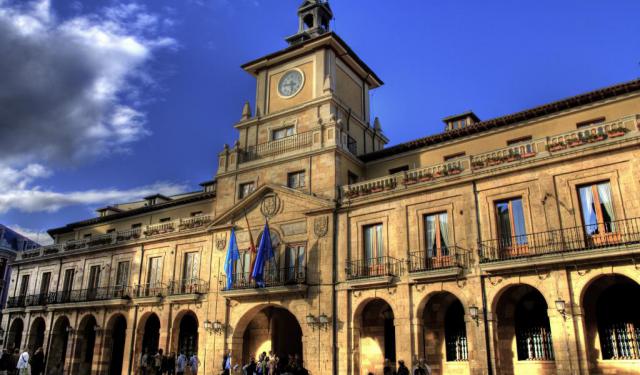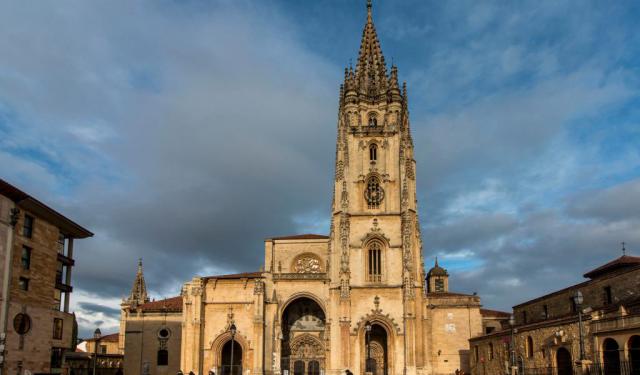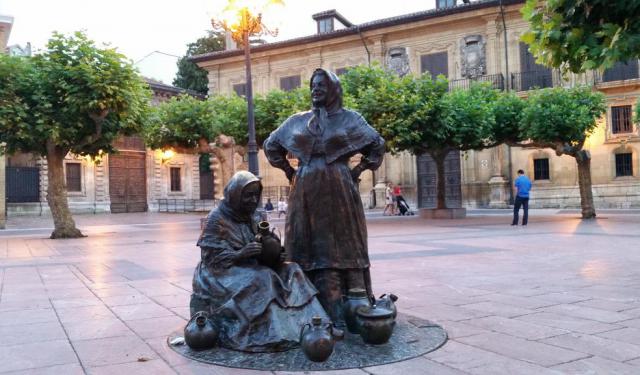
Iglesia de San Tirso (Church of Saint Thyrsus), Oviedo
The original Church of San Tirso, built by Tioda, the royal architect of Alfonso II of Asturias, back in the 790s, served as a royal chapel. Over the centuries, it has endured numerous modifications.
The building was completely transformed at the end of the 12th century, during the Romanesque period, and then in the 14th century when a large part of it was rebuilt. The Great Fire of Oviedo in 1521 nearly totally destroyed the temple. Another round of alterations followed in the 18th century, and the most recent one occurred during the 20th century, ultimately removing most of the original features, except for the front wall of the apse and a triplet round-arched window in the rectangular sanctuary.
The rectangular interior has three naves (one central and two lateral) divided by pillars that support semicircular arches. Found inside these naves are the chapel of Santa Ana (to the south, added in the 16th century), the main altarpiece (in front) and, on the north side, a lateral corridor. The church has three floors, two of which are underground.
The interior is crowned with a Gothic ribbed vault that rests upon the corbels with angels supporting shields. In the easternmost bay, owing to the smaller span, the arch was made sufficiently pointed to raise its crown to the same height as the others.
Highlights of the main chapel's altarpiece include the image of the Assumption, the sculpture of San Tirso by Antonio Borja, a Pieta, the altarpiece of Christ, and the triptychs by Francisco Reiter.
Located inside the church is also the tomb of Balesquita Giráldez, founder of the Balesquida Chapel.
The Church of San Tirso has been listed as an Asset of Cultural Interest since 1931.
The building was completely transformed at the end of the 12th century, during the Romanesque period, and then in the 14th century when a large part of it was rebuilt. The Great Fire of Oviedo in 1521 nearly totally destroyed the temple. Another round of alterations followed in the 18th century, and the most recent one occurred during the 20th century, ultimately removing most of the original features, except for the front wall of the apse and a triplet round-arched window in the rectangular sanctuary.
The rectangular interior has three naves (one central and two lateral) divided by pillars that support semicircular arches. Found inside these naves are the chapel of Santa Ana (to the south, added in the 16th century), the main altarpiece (in front) and, on the north side, a lateral corridor. The church has three floors, two of which are underground.
The interior is crowned with a Gothic ribbed vault that rests upon the corbels with angels supporting shields. In the easternmost bay, owing to the smaller span, the arch was made sufficiently pointed to raise its crown to the same height as the others.
Highlights of the main chapel's altarpiece include the image of the Assumption, the sculpture of San Tirso by Antonio Borja, a Pieta, the altarpiece of Christ, and the triptychs by Francisco Reiter.
Located inside the church is also the tomb of Balesquita Giráldez, founder of the Balesquida Chapel.
The Church of San Tirso has been listed as an Asset of Cultural Interest since 1931.
Sight description based on Wikipedia.
Want to visit this sight? Check out these Self-Guided Walking Tours in Oviedo. Alternatively, you can download the mobile app "GPSmyCity: Walks in 1K+ Cities" from Apple App Store or Google Play Store. The app turns your mobile device to a personal tour guide and it works offline, so no data plan is needed when traveling abroad.
Iglesia de San Tirso (Church of Saint Thyrsus) on Map
Sight Name: Iglesia de San Tirso (Church of Saint Thyrsus)
Sight Location: Oviedo, Spain (See walking tours in Oviedo)
Sight Type: Religious
Guide(s) Containing This Sight:
Sight Location: Oviedo, Spain (See walking tours in Oviedo)
Sight Type: Religious
Guide(s) Containing This Sight:
Walking Tours in Oviedo, Spain
Create Your Own Walk in Oviedo
Creating your own self-guided walk in Oviedo is easy and fun. Choose the city attractions that you want to see and a walk route map will be created just for you. You can even set your hotel as the start point of the walk.
Oviedo Historic Architecture
The north Spanish region of Asturias and particularly its capital city, Oviedo, have long been noted for their unique architecture. The medieval part of town, whose ancient walls are still largely intact, contains some truly priceless relics. Among them is a well called La Foncalada, a fascinating example of an effective hydraulic system, dating back to the first half of the 9th century, based on... view more
Tour Duration: 2 Hour(s)
Travel Distance: 2.7 Km or 1.7 Miles
Tour Duration: 2 Hour(s)
Travel Distance: 2.7 Km or 1.7 Miles
Oviedo Introduction Walking Tour
The Kingdom of Asturias began in 720, with the Visigothic revolt against Muslim rule led by the nobleman Pelagius. At that time, the city of Oviedo did not exist. Two monks, Maximo and Fromestano, founded the city in 761. They built a small church for Saint Vincent on a bare hillside, and from this seed, Oviedo grew.
After Pelagius died in 737, King Alfonso I founded a dynasty in Oviedo that... view more
Tour Duration: 1 Hour(s)
Travel Distance: 1.8 Km or 1.1 Miles
After Pelagius died in 737, King Alfonso I founded a dynasty in Oviedo that... view more
Tour Duration: 1 Hour(s)
Travel Distance: 1.8 Km or 1.1 Miles
Oviedo Public Art Walking Tour
Public art adds a great deal of vibrancy and character to the cityscape of Oviedo, Spain, reflecting, among other things, its contemporary spirit. From the bustling Plaza Trascorrales to the serene Plaza Porlier De Oviedo, numerous sculptures have long become an integral part of the neighborhood, captivating passers-by in their numbers.
In Plaza Trascorrales, sculptures like The Fishwife and... view more
Tour Duration: 3 Hour(s)
Travel Distance: 3.0 Km or 1.9 Miles
In Plaza Trascorrales, sculptures like The Fishwife and... view more
Tour Duration: 3 Hour(s)
Travel Distance: 3.0 Km or 1.9 Miles



